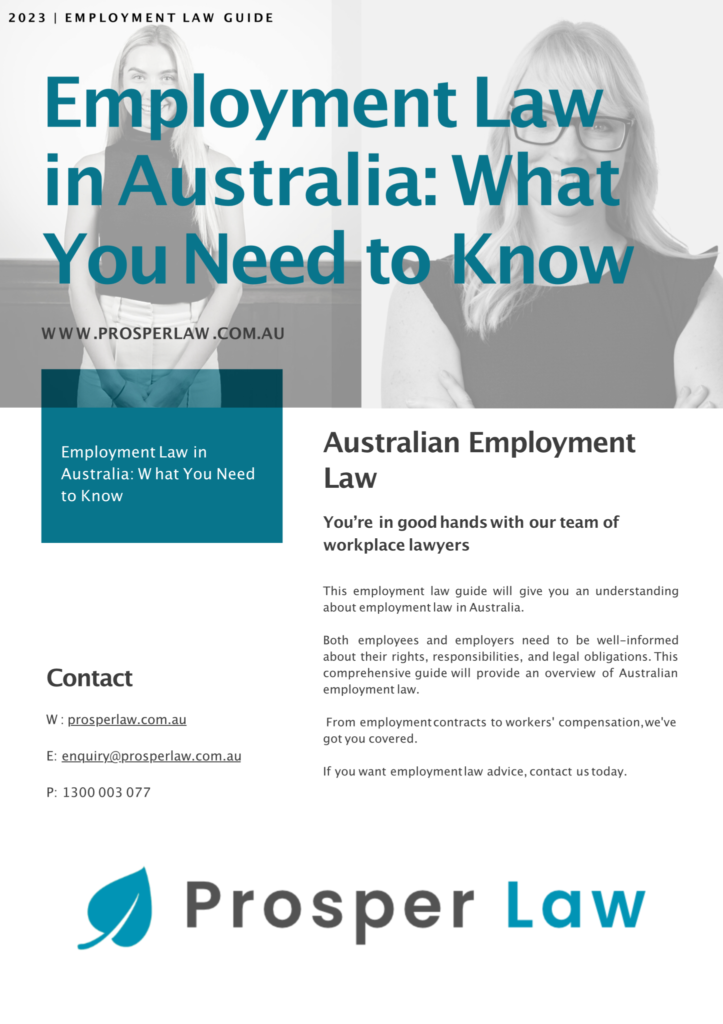Payment in lieu of notice plays an important role in the process of employment termination. Payments in lieu of notice allow employers to terminate an employee’s employment immediately. The employer must pay the employee the same amount they would have earned if they had worked the entire notice period.
This payment is also known as ‘pay instead of notice’. It must include the employee’s full pay for the hours they would have worked during the notice time. This includes regular pay for normal work hours. It also includes extra pay for allowances, overtime, penalty rates, and any other separate amounts the employee should have received.
The provision helps employees transition fairly, giving them financial security for a certain time and lets employers quickly manage their workforce.
Key takeaways
employers must give the minimum notice period to eligible employees
employers must ensure they have a legal right to make payments in lieu of notice
payment in lieu of notice must include an employee’s full rate of pay
you must give payments in lieu of notice before the date of notice
if an employer owes money to an employee, the employee can seek reimbursement by approaching the Fair Work Commission
minimum notice periods do not apply if an employee is terminated for serious misconduct
What notice periods does the Fair Work Act require?
Minimum notice period
Before you work out payments in lieu of notice, you need to know the required amount of notice.
It’s important to note that section 117 of the Fair Work Act sets out the minimum notice requirements. Section 117 of the Fair Work Act 2009 is fundamental to ensuring fair and lawful employment termination practices in Australia.
How much notice an employer must give before an employee’s employment ends can also depend on other things. An employee’s employment contract, Modern Awards and an Enterprise Agreement may provide for longer notice periods. If they do, employers must comply with these if they are more beneficial to the employee.
When someone needs to give notice
An employer cannot fire an employee without giving them written notice of the termination date. The employment agreement cannot be terminated before the day that notice is given. This requirement ensures that the company gives employees clear and certain notice of termination of employment.
The amount of notice required depends on:
the employee’s period of continuous service with the employer,
any relevant employment or workplace policy, and
what the agreement or employment contract says
As a minimum, the notice periods range from:
one week for an employee who has worked for the employer for less than a year, to
four weeks for an employee who has worked for the employer for more than five years, and
an additional week if the employee is over 45 years old and has completed at least two years of continuous service
An employer can choose to either let the employee work during their notice period or pay them instead. This payment must be equal to what the employee would have earned if they had worked through the full notice period. This includes the employee’s regular pay, as well as extra pay for overtime, penalties, allowances, and any other separate amounts.
A recent court decision has clarified the interpretation of section 117. The court held that for termination of employment to be lawful, payments in lieu of notice must not be made after the termination date. This decision underscores the importance of making payments in lieu of notice before the termination date to avoid potential legal repercussions.
When notice doesn’t apply
Further, a company does not need to provide a notice of termination or payment for employees who are:
casual employees
employed under a fixed-term contract
engaged to perform seasonal work
fired because of serious misconduct (for example, engaging in theft, fraud, assault or sexual harassment)
have a training arrangement and are employed for a set period of time or for the length of the training arrangement (this doesn’t apply to apprentices)
daily hire employees in the building and construction industry or in the meat industry in connection with the slaughter of livestock
weekly hire employees working in the meat industry and whose termination depends on seasonal factors
Does an employer have to provide pay in lieu of notice?
According to the National Employment Standards, an employer can choose to provide payment in lieu of notice. This means that instead of requiring the employee to work during the period, the employer can terminate the employment immediately and provide a payment equivalent to what the employee would have earned during the notice period.
What if the employment contract doesn’t give an option for payment in lieu?
If the employment contract is silent on the matter of payment in lieu of notice, it’s not clear whether an employer can choose to make such a payment. That is unless an employee agrees to be paid out their notice period. We recommend that this agreement be recorded in writing.
Any damages awarded for breach of contract are unlikely to exceed the wages paid in lieu of notice. However, complications may arise if the employee is entitled to payment under an incentive scheme. If a payment in lieu of notice results in the employee not qualifying for the incentive payment, the payment in lieu of notice might be considered insufficient.
We recommend that written employment contracts or industrial instruments are clearly written. They should explicitly state that the employer may choose to pay wages in lieu of all or part of an employee’s notice entitlement. This provides clarity for both parties and helps ensure compliance with the law.
Why would an employer give payment in lieu?
An employer may decide that they do not want the relationship to continue until the end of a notice period. A business may make this decision for a number of reasons, including:
they do not want the departing employee to negatively impact staff morale
the business is concerned about retaliation by the employee
the employment has ended on bad terms
the employer has a replacement worker and doesn’t need two people doing the same work
termination of employment can make the working relationship difficult and awkward
In my experience, employers sometimes also give pay in lieu because they want to end the employment relationship on good terms. People often view paying a worker for work they are not required to do as a bonus.
What amounts does payment in lieu of notice include?
When an employer opts to provide payment in lieu of notice, the amount payable must be equivalent to what the employee would have earned if they had worked through the full notice period.
The employer must make the payment in lieu of notice at the employee’s full rate of pay. This includes the employee’s base rate of pay, as well as any allowances, overtime, penalties, and other separately identifiable amounts the employee would have been entitled to.
This is required under section 117(2) of the Fair Work Act 2009.
Companies don’t usually hire employment lawyers to work out payments before an employer pays final payments. But, we’ve seen first hand the consequences where employers get this wrong.
Salary and wages up to the end of the notice period
The payment in lieu of notice must include an employee’s base rate of pay for the ordinary hours worked or would have been worked. If there are any outstanding wages, these also need to be paid out.
Annual leave
Most employees will accrue entitlements during their period of employment.
Annual leave does not accrue beyond the date payment is made in lieu of notice because employment ends on that date. Instead, annual leave is only paid out for annual leave that was accrued and not used up to the date of pay in lieu of notice.
On the other hand, a worker will continue to accrue annual leave if they remain employed during a period of notice.
Long service leave
Payments in lieu of notice will be higher if an employee has accrued an entitlement to long service leave. Long-service leave may apply where there has been a long period of continuous service.
The employer must pay any accrued long-service leave to the employee.
Allowances, overtime and penalty rates
Any monetary allowances that employees would have received had they worked to the end of their notice period must be included in any payments in lieu of notice.
This could include things like travel allowances, meal allowances, or uniform allowances, depending on the terms of the employee’s contract. It will also include overtime pay if the employee would have been scheduled to work overtime during the period of notice.
Penalties that would have applied during the notice period must also be included. This could include higher rates of pay for weekend or night work, for example.
Other separately identifiable amounts (including commissions and bonuses)
Any other separately identifiable amounts that the employee would have been entitled to. This could include things like incentive-based payments or bonuses, depending on the terms of the employee’s contract. As we will see in the next section, it can also include the value of a company car.
Payment in lieu of notice and company car
The provision of a company car as part of an employee’s remuneration package has been the subject of legal debate. The key question often revolves around whether the car is primarily used for private or business purposes and how this affects the calculation of the employee’s earnings.
Zappia and Universal Music
The court considered the provision of a company car in the case of Zappia v Universal Music Australia Pty Ltd. The employee earned the car as part of their earnings when they primarily used it for private purposes. Further, it formed a significant part of the remuneration package.
The court said:
“Where a motor vehicle is provided to an employee in lieu of salary that might otherwise have been paid, it is appropriate that the private benefit derived by the employee from the provision of the motor vehicle be counted as part of the employee’s remuneration.
Where, however, the vehicle is provided for business purposes and the employee’s entitlement to private use is purely incidental, the provision of the motor vehicle should be treated no differently to the provision by the employer of any other tool or piece of equipment essential to the performance of the job.”
This ruling suggests that the nature of the vehicle’s use is a critical factor in determining whether it should be considered part of the employee’s earnings. If the vehicle is provided in lieu of salary and is primarily used for private purposes, it should be counted as part of the employee’s remuneration.
However, the outcome may be different if the vehicle is provided for business purposes and the employee’s private use is incidental. In that case, it may be treated as a tool or piece of equipment necessary for the job.
Rofin and Newton
In contrast, the case of Rofin Australia Pty Ltd v Newton focused on genuine salary sacrifice situations where the employee directs and arranges the payment. The employer did not need to count the tax on the car as part of the employee’s earnings. This ruling highlights the importance of the specific circumstances surrounding the provision of the vehicle and the arrangement between the company and the employee.
Sam Technology Engineers and Bernadou
The case of Sam Technology Engineers Pty Ltd v Mr Andrew Bernadou further clarified the treatment of a company car in an employee’s earnings. The court ruled that when an employee is provided with a fully maintained vehicle for business and private use, the value of the private use should be included in the employee’s annual rate of earnings.
The calculation of the private use value is based on excluding the vehicle’s business usage. You also need to consider the other costs and benefits of the remaining use.
Jerome and Valco Group
In Jerome Monteiro v Valco Group Australia Ltd, the superannuation on the vehicle allowance was not considered part of the employee’s earnings. This requirement is because the law requires it to be remitted. This ruling shows the difference between parts of an employee’s pay and how they are treated legally.
Davidson and Adecco
In Mr Paul Davidson v Adecco Australia Pty Ltd, the court ruled that the business-use component of a motor vehicle allowance can be excluded from earnings. Only the private-use component is included. This ruling further emphasises the importance of the nature of the vehicle’s use in determining its treatment in an employee’s earnings.
Slavin and Horizon
Slavin v Horizon Holdings Pty Ltd considered a method for calculating the value of the motor vehicle as a part of an employee’s pay. The court ruled that the value can be calculated by determining the annual distance travelled for private purposes and multiplying it by the estimated cost per kilometre. The worker didn’t have a right in their contract to get the vehicle as part of their pay.
These cases highlight the difficulties involved in determining the value of a company car as part of an employee’s remuneration. It is important to consider the specific details of each situation. These details encompass the vehicle’s usage, the employer-employee agreement, and the payment package.







